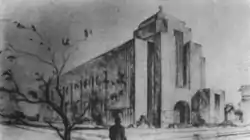New Synagogue (Shanghai)
The New Synagogue was an Ashkenazi synagogue in Shanghai, China, opened in 1941 to serve the city's then growing Russian Jewish community. It was located on rue Tenant de la Tour in the Shanghai French Concession. The synagogue was closed in 1965 after the departure of most Jews from Shanghai following the Communist victory in China, and was repurposed as the auditorium of the Shanghai Institute of Education. It was demolished in the 1990s.
| New Synagogue | |
|---|---|
拉都會堂 | |
 Sketch of the proposed New Synagogue, from the 15 January 1937 issue of Israel's Messenger | |
| General information | |
| Address | 102 rue Tenant de la Tour |
| Town or city | Shanghai |
| Country | China |
| Coordinates | 31.2153°N 121.4566°E |
| Completed | 1941 |
| Demolished | 1990s |
| Other information | |
| Seating capacity | 1,000 |
| Tenant de la Tour Synagogue | |||||||||
|---|---|---|---|---|---|---|---|---|---|
| Traditional Chinese | 拉都會堂 | ||||||||
| Simplified Chinese | 拉都会堂 | ||||||||
| |||||||||
History
The New Synagogue was built by the Russian Jewish community of Shanghai.[1] During the 1930s, the number of Russian Jews in the city increased to more than 4,000, exceeding the capacity of the existing Ohel Moshe Synagogue in Hongkew. After years of fundraising and construction under the leadership of Rabbi Ashkenazi, the synagogue was opened just in time for Passover in 1941.[1] Ashkenazi served as its rabbi, and the Shanghai Ashkenazi Jewish Communal Association (SAJCA) also moved to the New Synagogue. It was located at 102 rue Tenant de la Tour (Ladu Lu in Chinese, now South Xiangyang Road) in the Shanghai French Concession, and was commonly called the Tenant de la Tour or Ladu Synagogue.[1]
With a capacity for 1,000 people,[1] the New Synagogue was described as a "grand" and "splendid" building.[2][3] The Japanese, who had occupied the Chinese sections of the city since the 1937 Battle of Shanghai, provided tons of cement, a precious commodity during the ongoing Second Sino-Japanese War, for the foundation of the New Synagogue.[2] Soon after the synagogue was opened, however, the Pacific War broke out on 8 December 1941. The Japanese army occupied the Shanghai French Concession and the Shanghai International Settlement, and took over the synagogue for their own use. It was returned to the Russian Jewish community after the end of World War II.[1]
With the eruption of the Chinese Civil War and the subsequent establishment of the People's Republic of China in 1949, the Jewish population in Shanghai plummeted. In the 1960s, the New Synagogue became the "united" synagogue for all Jews, both Ashkenazim and Sephardim, still remaining in the city. It finally closed in 1965.[1] The synagogue was later used as the auditorium of the Shanghai Institute of Education.[4] It was demolished in the 1990s.[1]
References
- "犹太教场所" [Jewish places of worship]. Shanghai Chronicle (in Chinese). Shanghai Municipal Government. Retrieved 13 March 2019.
- Ristaino, Marcia Reynders (November 2003). Port of Last Resort: The Diaspora Communities of Shanghai. Stanford University Press. p. 155. ISBN 978-0-8047-5023-3.
- Eber, Irene (2 April 2012). Wartime Shanghai and the Jewish Refugees from Central Europe: Survival, Co-Existence, and Identity in a Multi-Ethnic City. Walter de Gruyter. p. 146. ISBN 978-3-11-026818-8.
- Tobias, Sigmund (1 January 1999). Strange Haven: A Jewish Childhood in Wartime Shanghai. University of Illinois Press. p. 141. ISBN 978-0-252-02453-5.